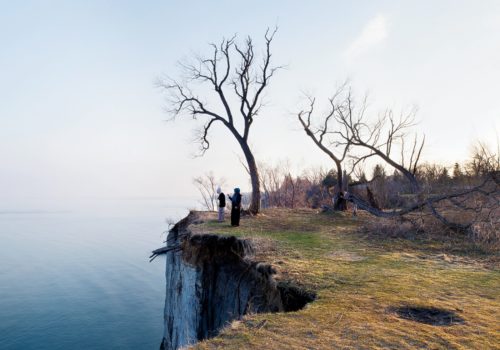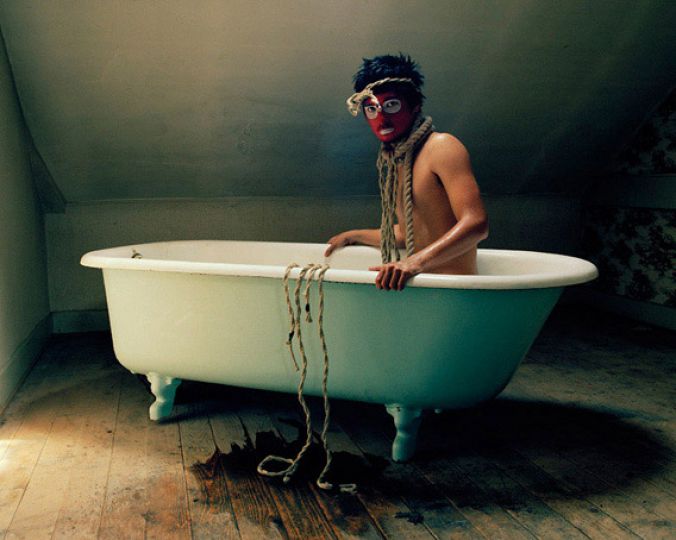While Canada is celebrating its 150th anniversary, Scotiabank CONTACT Photography Festival is offering an entire month dedicated to photography in all its forms in Toronto. This interdisciplinary festival of 2017 focuses on the subject of the Canadian Confederation’s sesquicentenary and the issues resulting from it. Identity, memory, environment, and colonial history of the country are this edition’s recurring questions.
The name Canada comes from the name “Kanata”, signifying “village” in Huron (the Native American nation Huron-Wendat being from the south of Ontario). We are well aware of the oxymoron present, since this “village” today represents one of the biggest countries in the world, gathering more than fifty First Nations and around 200 ethnic origins. This sociocultural diversity makes it impossible to capture Canada in its entirety, to describe or get a sense of it through one particular event. The sesquicentenary is a good occasion to look at identity, or rather Canadian identities at the current time. That is what CONTACT 2017 asks through different themes.
Reflecting on Canada’s history also requires definition of national space; Canadian landscape is actually one of the festival’s central subjects. Numerous exhibitions evoke questions of sovereignty, patriotism, and identity through alternate histories of the land and countryside. The collective exhibition What does one do with such a clairvoyant image? at Gallery 44 or Habitat by Louis Jacob at Gallery TPW are some examples. It’s All Happening So Fast: A Counter-History of the Modern Canadian Environment at the Art Museum at the University of Toronto contests Canada’s fundamental hypothesis in its perception and relationship regarding nature. These propositions are also taking a critical look at the territory since Canada has a rather weak environmental track-record among industrial countries today.
Rapid urbanization that took place over the 20th century saw the North American landscape profoundly transform. An Enduring Wilderness: Toronto’s Natural Parklands, the Robert Burley exhibition at John B. Aird Gallery, evokes a certain nostalgia for nature through which shines an idyllic vision and harmony now vanished.
While Burley rediscovered a pastoral experience in the urban parks of Ontario’s capital, other artists are approaching the subject of architecture and urban development. The previously mentioned exhibition Habitat, just like the video installation Canada by Mark Lewis at AGO (Art Gallery of Ontario), explores the urban environment as seen through the critical angle of continuous expansion and industrialization. The short films from Souvenir, presented at Ryerson Image Centre, create an image of this rapid urbanization from the point of view of indigenous communities who left the northern territories to move to the southern city. The internal mobility and migration of the First Nations of Canada are not without problems.
The four films from the Souvenir exhibition, created by contemporary indigenous artists Jeff Barnaby, Michelle Latimer, Kent Monkman, and Caroline Monnet, discuss the complicated history of the First Nations with power and honesty. Reworking images form the National Film Board of Canada’s archives, they offer a poignant critique on Canada’s colonial history as well as the current question. In his series Coastal presented at Harbourfront Centre, Johan Hallberg-Campbell also explores the cultures of indigenous communities. His beautiful work, which consists of a video installation, large-scale prints presented as a set entirely covering the walls, and images exhibited in the public space, uncovers the lives of fishermen from the far north and re-contextualizes our relationship with this former legacy.
The coasts are also the subject of the exhibition Newfoundlandings by Michael Snow, one of the most famous Canadian artists. His work presented at Prefix Institute of Contemporary Art leads us to a region of Canada, Newfoundland, which only joined the confederation in 1949, and whose membership is still contested today by certain people. The most Asian province of the country sensitively illustrates the controversial history of the most diverse regions of Canada marked by colonization and abandon.
The cultural heritage as well as the modern and contemporary history of black communities are also a part of the festival’s panorama of questions. Free Black North at AGO is gathering the photographs of descendants from refugees and former slaves of the south of the United States living in Ontario during the second half of the 19th century. Ears, Eyes, Voice: Black Canadian Photojournalists 1970s-1990s from BAND Gallery is not only presenting portraits but is also expressing the strength and power of these communities. The exhibition gathers press photos from Jules Elder, Eddie Grant, Diane Liverpool, Al Peabody, and Jim Russell– authors who themselves were targets of racist acts.
In America, everyone has a history of migration, often several. Each of these personal stories reveals the different levels of the question of identity and belonging. Besides portraits of marginalized individuals or influential community members (politicians, activists, protestors, stars, athletes), profound questions are also found in the large number of exhibitions of found photos and anonymous family albums in the festival. The Family Camera: Missing Chapters presented at the Art Gallery of Mississauga and the Royal Ontario Museum explores social, political, and also technological factors that amateur and family photos can have over an individual’s experience. The installation As Yet Untitled by Max Dean at Ryerson Image Centre, meditates on our relationship with these intimate images by treating them like abandoned objects. The robot systematically destroys them unless the visitor intervenes.
These personal stories are not only from the past. The young members of the second generation and admitted immigrants are also offering pertinent subject matter. In her exhibition Pacifier at CONTACT Gallery, Petra Collins portrays her aging family and the complex life of adolescents. From a Moroccan household in Paris and living in Montreal for the past fifteen years, 2Fik plays in between documentary and fiction to deconstruct stereotypes. His series His and Other Stories at Coffer Gallery forces the viewer to challenge his own sense of self and to reflect on notions of gender, sexuality, belief, universality, and alterity.
Gender, sex, and self-definition are also central subjects for Suzy Lake, winner of the Scotiabank Photography Award 2016. Her exhibition at Ryerson Image Centre retraces the artist’s journey from 1976. Always trying to push the boundaries of the medium, Lake explores photography with a conceptual approach, all while highlighting current social issues.
The artist bringing home the prize this year is Shelley Niro. Her work Battlefields of my Ancestors is currently on view at Ryerson University as well as Fort York National Historic Site as a public installation. Her work perfectly reflects the issues of this festival’s edition. An interdisciplinary artist, Niro takes a critical look at the representation of indigenous women and the interpretation of identity and culture of the First Nations, as well as the Canadian landscape. Her personal exhibition will be presented next year at Ryerson Image Centre as part of Toronto’s CONTACT festival.
Orsolya Elek
Orsolya Elek is a photographer, a webmaster and a cultural marketing agent. She lives and works in Paris.
Scotiabank CONTACT Photography Festival
May 2017
Various locations around Toronto
Canada

















